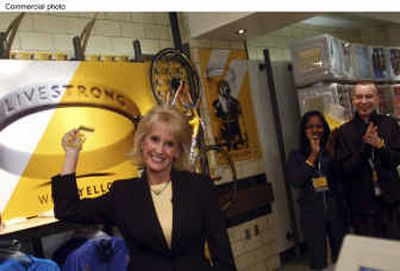Bracelets generate more than awareness

How ubiquitous are those bright yellow Livestrong bracelets? Consider that when the campaign for cancer survivors hits the one-year mark Tuesday, 50 million of the $1 bracelets will have been sold, according to the Lance Armstrong Foundation. It was founded by the cyclist after he survived testicular cancer.
That’s one for every six Americans or the entire populations of New York, Florida and Illinois.
The original revenue projection for the program was $6 million, with $5 million of that guaranteed by Armstrong sponsor Nike.
The Foundation directs the program and already has funded grants for cancer survivorship programs and testicular cancer direct research. Livestrong was launched in the months before July 2004 when Armstrong successfully become the first rider to win six consecutive Tour de France championships. His team – and rock star girlfriend Sheryl Crow – wore the bracelets during the tour. Soon even race rivals began to sport them as a sign of solidarity with Armstrong’s inspirational crusade.
Hollywood celebrities such as Pamela Anderson and Ashley Judd were photographed wearing the yellow plastic bands with designer gowns on the red carpet.
Politicians, including Democratic presidential candidate John Kerry, let the bracelets conspicuously show beneath their starched cuffs.
Kids everywhere wore them on wrists and ankles, and parents were soon under pressure to secure the hot items lest their children be seen as uncool.
By the time school started last fall, Livestrong blossomed into a full-blown, brand-driven fad.
“The Livestrong bracelets have become a global trend because they have all the elements of a successful and enduring brand,” says trend guru Al Kahn, CEO of 4Kids Entertainment and mastermind of the Pokemon, Cabbage Patch Kids and Yu-Gi-Oh toy phenomena. “They’re fun, easily identified but hard to find, and make a positive statement about the wearer.”
Like most fads, Livestrong spawned a legion of knock-offs and rip-offs. Middle-school kids now adorn their arms with a rainbow of bracelets for various causes.
To keep the program growing, new official Livestrong products are hitting the market. Trek is selling replicas of the black-and-yellow Livestrong bike that Armstrong rode on his victory lap in Paris last July. Nike has created a line of cycling gear and casual clothing for Livestrong. That brand is named “10/2” in honor of Oct. 2, 1996, the date Armstrong was diagnosed.